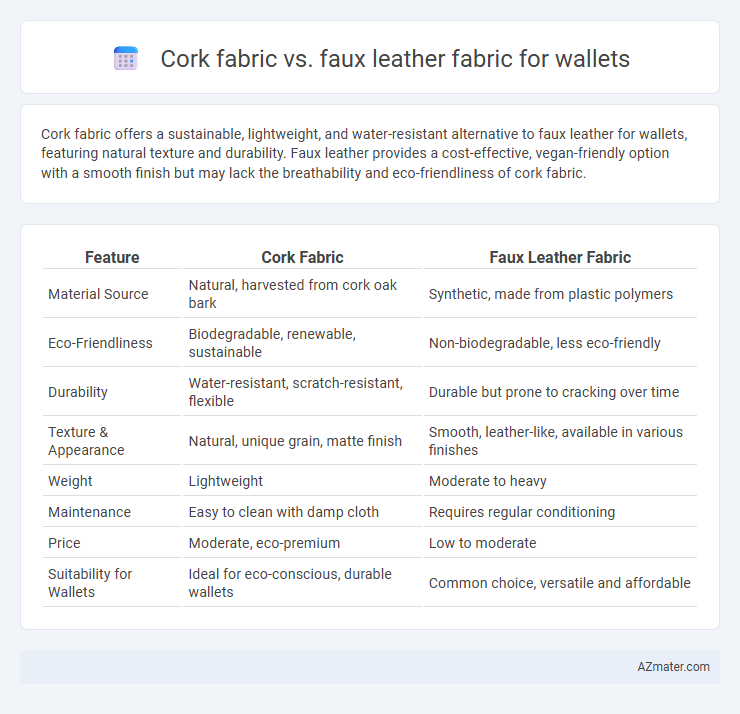Cork fabric offers a sustainable, lightweight, and water-resistant alternative to faux leather for wallets, featuring natural texture and durability. Faux leather provides a cost-effective, vegan-friendly option with a smooth finish but may lack the breathability and eco-friendliness of cork fabric.
Table of Comparison
| Feature | Cork Fabric | Faux Leather Fabric |
|---|---|---|
| Material Source | Natural, harvested from cork oak bark | Synthetic, made from plastic polymers |
| Eco-Friendliness | Biodegradable, renewable, sustainable | Non-biodegradable, less eco-friendly |
| Durability | Water-resistant, scratch-resistant, flexible | Durable but prone to cracking over time |
| Texture & Appearance | Natural, unique grain, matte finish | Smooth, leather-like, available in various finishes |
| Weight | Lightweight | Moderate to heavy |
| Maintenance | Easy to clean with damp cloth | Requires regular conditioning |
| Price | Moderate, eco-premium | Low to moderate |
| Suitability for Wallets | Ideal for eco-conscious, durable wallets | Common choice, versatile and affordable |
Introduction: Cork Fabric vs Faux Leather for Wallets
Cork fabric offers a sustainable, lightweight, and water-resistant alternative to traditional materials, making it an ideal choice for eco-conscious wallet designs. Faux leather mimics genuine leather's texture and durability while avoiding animal products, appealing to ethical consumers seeking stylish and affordable options. Both materials provide distinct benefits, with cork emphasizing environmental impact and faux leather focusing on versatility and cost-effectiveness.
Material Origins: Understanding Cork Fabric
Cork fabric is derived from the bark of the cork oak tree, harvested sustainably without harming the tree, making it an eco-friendly and renewable material ideal for wallets. Unlike faux leather, which is typically made from plastic-based materials like polyurethane, cork fabric offers natural breathability, lightweight durability, and resistance to water and scratches. This organic origin enhances its appeal among environmentally conscious consumers seeking stylish, sustainable wallet options.
Material Origins: The Making of Faux Leather
Faux leather fabric is primarily made from synthetic materials such as polyurethane (PU) or polyvinyl chloride (PVC), derived from petrochemicals through complex manufacturing processes that involve coating a fabric base with polymer layers to mimic the appearance and texture of genuine leather. This synthetic origin contrasts with cork fabric, which is harvested sustainably from the bark of cork oak trees, making it a natural, renewable resource. The production of faux leather involves chemical treatments and plasticizers that affect durability and environmental impact, whereas cork fabric emphasizes eco-friendliness and biodegradability.
Sustainability: Eco-Friendliness Comparison
Cork fabric, derived from the renewable bark of cork oak trees, offers exceptional sustainability by being biodegradable, recyclable, and harvested without tree felling, making it an eco-friendly alternative for wallet production. Faux leather, often made from polyurethane or PVC, poses environmental challenges due to its reliance on petrochemicals and limited biodegradability, contributing to microplastic pollution and landfill waste. Choosing cork fabric supports reduced carbon footprint and sustainable forest management, positioning it as a more environmentally responsible material compared to conventional faux leather for wallets.
Durability in Everyday Use
Cork fabric offers exceptional durability for wallets, resisting wear and tear while remaining lightweight and water-resistant, making it ideal for everyday use. Faux leather provides a stylish alternative but tends to show scratches and cracks over time, especially with frequent handling. Cork's natural resilience and sustainable production make it a longer-lasting choice compared to synthetic faux leather in daily wallet use.
Aesthetics and Style Options
Cork fabric offers a natural, textured appearance with unique grain patterns that develop more character over time, appealing to eco-conscious consumers who prefer organic aesthetics. Faux leather fabric provides a smooth, polished finish available in diverse colors and patterns that mimic genuine leather's luxurious look, enabling versatile design choices for stylish, contemporary wallets. Cork emphasizes rustic, earthy charm, while faux leather caters to sleek, modern fashion trends, expanding style options based on individual preference.
Comfort and Texture Differences
Cork fabric offers a soft, lightweight, and breathable texture, providing superior comfort for wallets through its natural flexibility and smooth feel. Faux leather, while durable and visually appealing with a grainy texture, tends to be stiffer and less breathable, potentially causing discomfort during extended use. The hypoallergenic and eco-friendly properties of cork fabric enhance its comfort advantage over synthetic faux leather, which may cause sweating or irritation.
Maintenance and Cleaning Tips
Cork fabric offers superior resistance to water and stains, requiring only a damp cloth for easy cleaning, making it highly low-maintenance compared to faux leather. Faux leather demands more careful care, often needing mild soap solutions to remove dirt and occasional conditioning to prevent cracking or peeling. Both materials benefit from avoiding prolonged exposure to direct sunlight and excessive moisture to maintain the wallet's durability and appearance.
Price Comparison: Which Offers Better Value?
Cork fabric for wallets presents a cost-effective alternative to faux leather, typically priced lower due to sustainable harvesting and minimal processing. Faux leather, while offering a luxurious look, often carries higher manufacturing costs related to synthetic materials and finishes, impacting its retail price. Choosing cork fabric generally delivers better value for consumers seeking affordability without sacrificing durability and eco-friendliness.
Final Verdict: Choosing the Right Material for Your Wallet
Cork fabric offers eco-friendly durability and a lightweight, water-resistant texture ideal for sustainable wallets, while faux leather provides a stylish, affordable alternative with a classic leather appearance and easy maintenance. Consider cork for a unique, natural feel with environmental benefits, and choose faux leather for versatility, wide color options, and budget-conscious fashion. The final verdict depends on your preference for sustainability and texture versus classic style and cost efficiency.

Infographic: Cork fabric vs Faux leather fabric for Wallet
 azmater.com
azmater.com